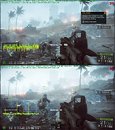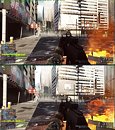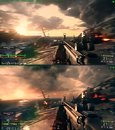Thursday, January 30th 2014

DICE Posts its Own Battlefield 4 DirectX vs. Mantle Performance Numbers
Along with its highly anticipated game patch that includes an AMD Mantle renderer for Battlefield 4, DICE posted numbers from its own testing, pointing out the performance difference between DirectX 11.1 and Mantle. DICE put Battlefield 4 through three test scenarios, entry-level gaming, mainstream gaming, and enthusiast gaming. The entry-level test-bed comprised of an AMD A10-7850K APU, with its integrated Radeon R7 200 series GPU (512 stream processors, 720 MHz GPU clock). This is a CPU and GPU limited scenario, in which the game was tested at 1280 x 720 pixels resolution. DICE notes that with Mantle, the game yielded about 14 percent higher frame-rates.
Next up, is mainstream gaming. The test-bed runs an AMD FX-8350, which offers roughly the same gaming CPU performance as a Core i5-3570K. A Radeon HD 7970 is in charge of graphics, and the game is run at 1920 x 1080 pixels resolution, with 1x MSAA and "Ultra" preset. DICE found that the setup yields about 26 percent higher frame-rates. Lastly, there's the enthusiast test-bed, running an Intel Core i7-3960X CPU, and dual Radeon R9 290X (CrossFire) graphics. The resolution stayed at 1920 x 1080, settings at "Ultra" preset, but the anti-aliasing was cranked up to 4x MSAA. The result? A stunning 58 percent higher frame-rates. It's important to note here that in addition to settings, the other thing that's not constant between the three setups is the test scene. Even if DICE' assessment is most generous towards AMD's claims, there really does seem to be a performance increment on offer, with Mantle. Can't wait to check it out for ourselves. For more details and notes from the developer, check out the source link.
Source:
DICE
Next up, is mainstream gaming. The test-bed runs an AMD FX-8350, which offers roughly the same gaming CPU performance as a Core i5-3570K. A Radeon HD 7970 is in charge of graphics, and the game is run at 1920 x 1080 pixels resolution, with 1x MSAA and "Ultra" preset. DICE found that the setup yields about 26 percent higher frame-rates. Lastly, there's the enthusiast test-bed, running an Intel Core i7-3960X CPU, and dual Radeon R9 290X (CrossFire) graphics. The resolution stayed at 1920 x 1080, settings at "Ultra" preset, but the anti-aliasing was cranked up to 4x MSAA. The result? A stunning 58 percent higher frame-rates. It's important to note here that in addition to settings, the other thing that's not constant between the three setups is the test scene. Even if DICE' assessment is most generous towards AMD's claims, there really does seem to be a performance increment on offer, with Mantle. Can't wait to check it out for ourselves. For more details and notes from the developer, check out the source link.



63 Comments on DICE Posts its Own Battlefield 4 DirectX vs. Mantle Performance Numbers
- Core i7-4960X CPU + R9 290X GPU
- 1080p, Ultra Preset, 4xAA: 9.2% improvement with Mantle
- 1600p, Ultra Preset, 4xAA: 10% improvement with Mantle
- Core i7-4960X CPU + R7 260X GPU
- 1080p, Ultra Preset, 4xAA: 2.7% improvement
- 1600p, Ultra Preset, 4xAA: 1.4% improvement
- A10-7700K CPU + R9 290X GPU
- 1080p, Ultra Preset, 4xAA: 40.9% improvement
- 1600p, Ultra Preset, 4xAA: 17.3% improvement
- A10-7700K CPU + R7 260X GPU
- 1080p, Ultra Preset, 4xAA: 8.3% improvement
- 1600p, Low Preset: 16.8% improvement
Source: wccftech.com/amd-launches-mantle-beta-low-end-cpus-not-gpus/As a matter of fact that worked for all N64 games.
Wait... What??
What's interesting is the graph.
on pic 2 and 3 i can't make out but think Mantle is on bottom of all .
From Johan Andersson's Mantle blog:Also,
And DirectX 11,11.2 was support?
I think this technology is not practical.